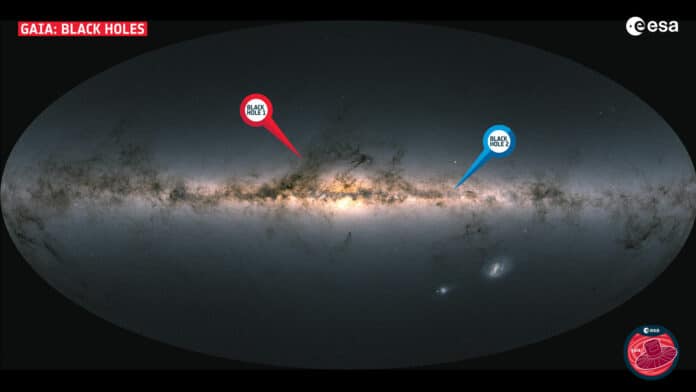Using data from ESA’s Gaia mission while studying the movement of their companion stars, astronomers have discovered a new family of black holes. The black holes, Gaia BH1 and Gaia BH2, are approximately ten times more massive than our Sun.
The Gaia BH1 and Gaia BH2 black holes are situated just 1560 and 3800 light-years distant from Earth, respectively, in the direction of the constellations Ophiuchus and Centaurus. These black holes are located in our cosmic backyard.
The gravitational impacts of the new black holes are the only way to identify them because they are black. Compared to other known binary systems of black holes and stars, the distance between the stars and the black hole is substantially greater, as are the stars’ orbits around it. These nearby star-black hole couples, referred to as X-ray binaries, are frequently very bright in radio and X-ray light and are, therefore, simpler to discover. Yet, the most recent findings imply that black holes in broader binaries are more frequent.
Kareem El-Badry, discoverer of the new black holes and researcher at the Harvard-Smithsonian Center for Astrophysics in the US and the Max-Planck Institute for Astronomy in Heidelberg, Germany, said, “What sets this new group of black holes apart from the ones we already knew about is their wide separation from their companion stars. These black holes likely have a completely different formation history than X-ray binaries.”
Timo Prusti, ESA‘s Gaia project scientist, said, “The accuracy of Gaia’s data was essential for this discovery. The black holes were found by spotting the tiny wobble of its companion star while orbiting around it. No other instrument is capable of such measurements.”
Thanks to Gaia for offering precise measurements of the movement in three directions, but to understand more precisely how the stars moved away and towards us, additional radial velocity measurements were needed. They were provided by ground-based observatories for the recently discovered black holes and thus provided the final piece of evidence that the astronomers had discovered black holes.
Because the new sort of black hole is significantly farther away from its companion stars, they do not emit any light, making them virtually undetectable. The orbits of the two Gaia black holes are the furthest apart from any known black holes. These are also the nearest black holes to Earth that are currently known, which means that there is still a great deal of undiscovered wide binaries with black holes similar to them.
Yvette Cendes, who helped discover the second black hole and is an astronomer at the Harvard-Smithsonian Center for Astrophysics in the US, said, “This is very exciting because it now implies that these black holes in wide orbits are common in space – more common than binaries where the black hole and star are closer. But the trouble is detecting them. The good news is that Gaia is still taking data, and its next data release (in 2025) will contain many more of these stars with mystery black hole companions in it.”
Journal Reference:
- “A red giant orbiting a black hole” by Kareem El-Badry et al. is published in the Monthly Notices of the Royal Astronomical Society (MNRAS). DOI: 10.1093/mnras/stad799
